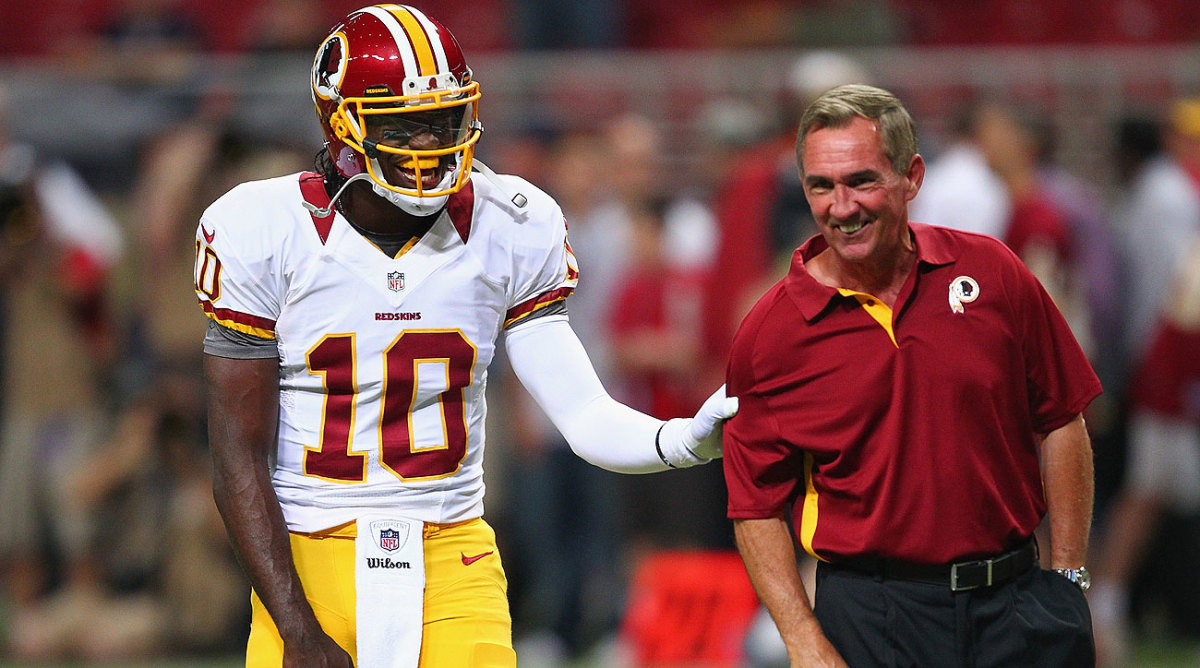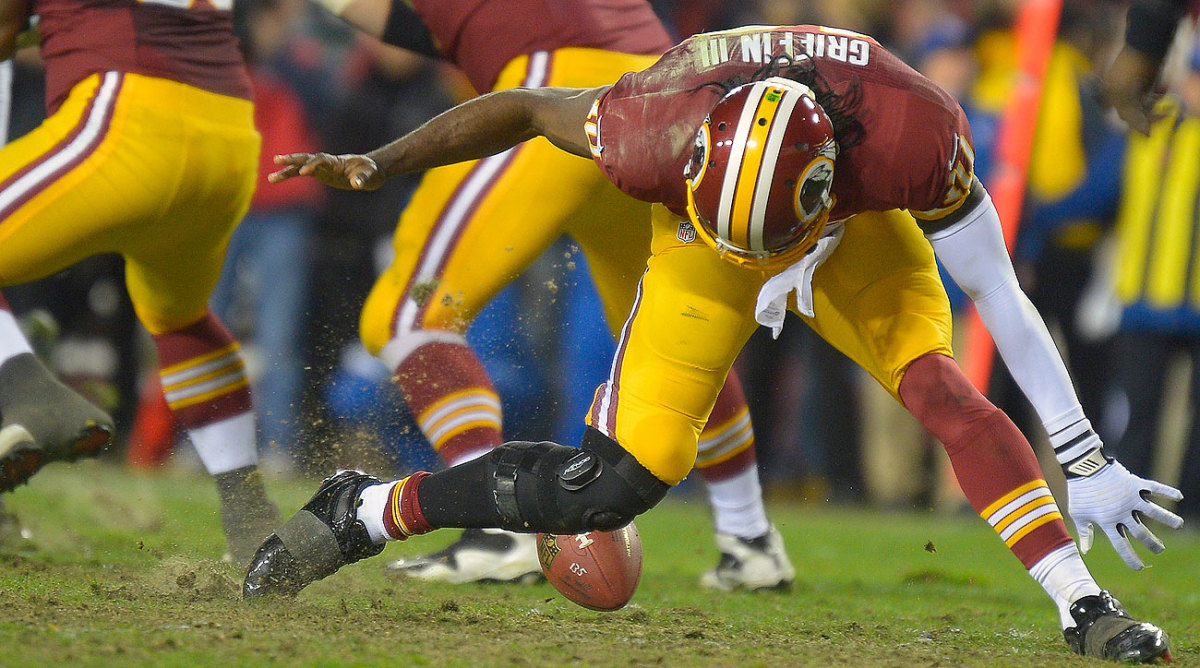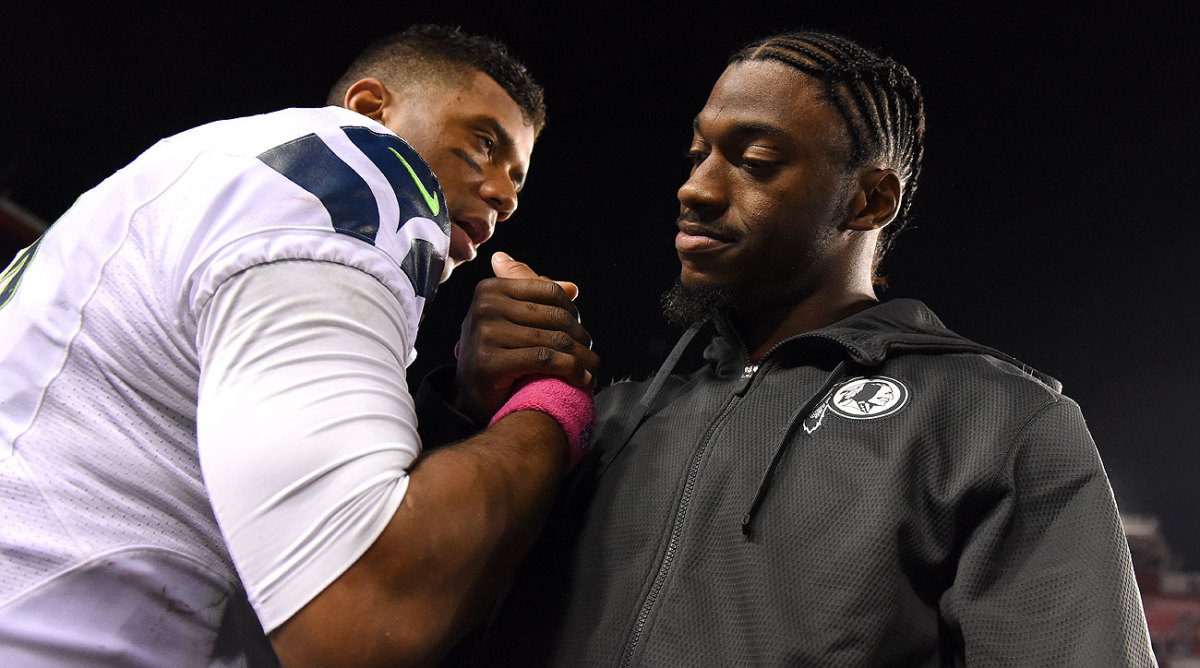No More Hope

The signs were there all summer. And on the last day of August, Washington coach Jay Gruden—in a move that close observers of the team felt was a long time coming, in part because it runs against owner Daniel Snyder’s grain—yanked Robert Griffin III from the starting quarterback job.
Kirk Cousins, the 102nd pick in the 2012 draft, plays. Griffin, the second pick in the 2012 draft, sits.
At Washington's training camp in Richmond, Va., exactly a month ago, I ran into Gruden. He said the team was going to support Griffin and give him every chance to succeed, and not put all the pressure of the offense or the franchise on him. He never said: Robert’s my guy. We’re going to sink or swim with Robert.
Then I spent 20 minutes post-practice with Griffin, who said, among other things:
“They are asking me to be basic and take the plays that are there. If that’s what Jay wants me to do, that’s what I’m going to do.”
“If they are asking me to do the ordinary, that’s what I am going to have to do.”
“I just have to do what the coach asks me to do.”
“I’m a player and he’s the coach and he’s going to go out there and make the play calls, and I have to go execute them.”
Griffin never said: This is a great offense for me, and I’ve got faith in Jay Gruden to put me in the best position to play well and win.
Is there any question, any logical thought, about keeping Griffin and making him the number two or three quarterback? If Washington does that, it’s not because Gruden or general manager Scot McCloughan wants Griffin on the roster. It’s because the owner does. Now we’ll wait to see how many of its losses Washington really wants to cut.
* * *

A proper post-mortem will take days, even weeks. But let’s go back and figure out as best we can how Robert Griffin III went from NFL Offensive Rookie of the Year and playoff quarterback to being demoted and, perhaps, on the verge of being shown the door in the span of 32 months.
Let’s start in 2012, when Griffin became the Taylor Swift of football. The sensation.
When Mike Shanahan coached in Denver, he fell in love with Jay Cutler before the 2006 draft and traded up four spots in the first round to get him. But with perfectly fine Jake Plummer already on the Broncos’ roster, Shanahan didn’t have to force Cutler into the lineup. He waited until late November 2006 to make the transition.
When Shanahan coached Washington, he had Rex Grossman and badly needed a quarterback upgrade. So Washington traded three first-round picks and a second-round pick to move up. With the second overall selection, Washington took the running quarterback with the great arm from Baylor. The day of the draft, in New York, there were Obama-like “HOPE” signs featuring the cartoonish visage of Griffin. He had become an icon and hadn’t even taken an NFL snap yet. How could Shanahan not start him?
During that summer’s training camp, I remember watching Griffin run with the ball seven times during a 20-play sequence of team drills, and I remember wondering how long he’d last playing that way. Shanahan told me it would take five years to mold Griffin into the kind of well-protected pocket passer who could have a long and successful NFL career. For the time being, Shanahan wanted to create an offense that catered to Griffin’s mobility and deep-arm strength while letting him make plays with his legs. By late November, RG3 was leading an unlikely playoff run. In back-to-back games, including a short Thanksgiving week, Griffin beat Philadelphia and Dallas by a combined 32 points, throwing eight touchdown passes and one interception, and rushing for 113 yards.
Griffin was becoming The Next Big Thing.
The next week, the Giants were in town for “Monday Night Football.” I went to the game and watched Griffin run an offense that coordinator Kyle Shanahan had designed well for him: 40 of the 51 snaps had Griffin either in shotgun (seven yards behind center) or in pistol (four yards behind center), with a back or tight end (or both) alongside Griffin, who ran this newfangled read-option run/pass illusion on many plays. Griffin would put the ball into the belly of running back Alfred Morris and either hand it off or keep it himself, so he could either take off running or pass out of play-action. It was a total game-changer for defenses. On this night, Griffin used the read-option to fake athletic defensive end Jason Pierre-Paul out of his shoes, sprinting 50 yards down the left side of the field while the crowd went bonkers. Washington beat the defending Super Bowl champs, 17-16.
“It’s been a complete culture shock for everybody,” tight end Logan Paulsen said then of the read-option. “I remember when we first put it in … It was kind of like learning to walk again. I guess I’m speaking for myself. You play football for a very long time—through high school, through college, and hae never been exposed to anything like this, and I think that’s a majority of the people in our offense.”
That night, a bunch of NBA players were at the game—Carmelo Anthony for one—to see what all the RG3 fuss was about. Griffin needed four security guards to make it from the locker room door through throngs of people in the parking lot to join his family’s tailgate. One fan even held a sign that implored Griffin to marry her.
Late in the 2012 season, the NFL Network had players cast votes to rank the league’s top 100 players. Consider three interesting rankings:
15) Robert Griffin III
23) Andrew Luck
51) Russell Wilson
The only quarterbacks to rank higher than Griffin were Tom Brady, Peyton Manning, Aaron Rodgers and Drew Brees.
Months later, I watched tape of the read-option with Kyle Shanahan and asked him to show me Griffin’s 50-yard run from the Monday night Giants game. Griffin took the snap on third-and-1, planted the ball in Morris’s gut while holding on to it, and rode Morris while staring to his left—at Pierre-Paul. Logan Paulson started the play across from Pierre-Paul, but the tight end made no attempt to block one of the most dangerous rush ends in football. He went to the next level and blocked safety Kenny Phillips, giving Pierre-Paul a free run at the RG3-Morris tandem. Why?
“Think about it this way,” Kyle Shanahan said. “Pierre-Paul and DeMarcus Ware are the biggest freaks I see every year. So when I prepare for these guys, I have to sit all week thinking, How are we going to handle this guy that nobody in the NFL is capable of handling on their own? What’s going to be our plan? Normally we put two or three on him. Now, you know what my plan is with the zone read? Let’s put nobody on him. So if he wants to go get Robert, Alf takes the ball. Go get Alf? Robert takes it. We used to wrack our brains all week, wondering how many guys have to help block him. Now all of a sudden, our plan is we’re not going to put anyone on him.”
Pierre-Paul locked onto the running back. Griffin kept the ball. Gain of 50. I counted five times in this game—out of Pierre-Paul’s 34 defensive snaps (he was limited with an aching back)—that Washington left him unblocked.
It seemed that the scheme, and Griffin’s ability to execute it, was revolutionizing the NFL. But an unfortunate thing happened on the way to the coronation: Griffin strained a knee in December against Baltimore, and the injury was worse than either he or the team let on. He wasn’t right the rest of the season. And that’s when everything started changing. The NFL Network hadn’t even announced him as the 15th-best player in the league yet—that would come in the offseason—but his football life was already spiraling downward.
* * *

Something changed when Griffin banged his knee against the Ravens. His father, a key cog in his early development as a player, already thought Washington was putting his son in harm’s way too often. And it continued to change when Griffin suffered an even more significant knee injury in the wild-card loss to Seattle, one that required reconstructive surgery.
As Griffin rehabbed to be ready for the start of the 2013 season, his father stewed about the injury and how the Shanahans were having his son play. Robert Griffin II told the Washington Post’s Dave Sheinin, “I just know based on what I know Robert can do, he doesn’t have to be a runner as much as I saw last year. To me you’re paying these [wide receivers] a lot of money to catch the football. I want him throwing that football, a lot. A lot.”
The relationship between Mike and Kyle Shanahan and their quarterback was already souring. The time between a quarterback’s first and second season is a vital window for learning, but because Griffin was rehabbing much of the offseason, he couldn’t adapt to some of the new stuff that the coaches had planned to install for him—stuff that would have made him more of a pocket passer.
With much of the read-option gone, Griffin was the Week 1 starter, but he failed miserably almost from the get-go. He just wasn’t healthy enough to run, even if the game plan called for him to do so. After a 45-10 home loss to the Chiefs dropped Washington to 3-10, Shanahan benched Griffin in favor of Cousins. Griffin’s season rushing total fell from 815 yards as a rookie to 489 (and rushing TDs dropped from 7 to 0), his passer rating fell 20 points, and his accuracy dropped 5.5 percentage points as well. The season was a debacle, and the Shanahan staff paid for it with their jobs.
Mike Shanahan reportedly hadn’t been happy with Griffin’s study habits, and he thought Griffin was a little too concerned with his personal brand rather than his football knowledge. When Jay Gruden was hired to replace Shanahan, olive branches were extended all around. Gruden had done such a good job in Cincinnati with a quarterback who had fewer tools—Andy Dalton—and he said all the right things when he came on board.
But Griffin was ineffective and injured again in 2014, missing six weeks with an ankle injury suffered in Week 2 and throwing just two touchdown passes in his first four starts. Things were unraveling, and after a 27-7 loss to Tampa Bay in Week 11, he uttered words that went over like a lead balloon in his locker room. “If you want to look at the good teams in the league and the great quarterbacks, the Peytons and the Aaron Rodgers, these guys don’t play well if their guys [supporting cast on offense] don’t play well. They don’t.”
Gruden told Griffin to pipe down “and worry about himself and not everybody else.”
This was a freight train rolling down the tracks now, and the only way Griffin could stop it was by playing great. He couldn’t. Gruden wanted a student of the game who could master the pocket. That wasn’t Griffin. By the time this summer rolled around, nothing had changed except the calendar. Griffin still talked too much; he wasn’t the student that Gruden wanted; and he wasn’t able to process the receiver progressions as well as either Kirk Cousins or Colt McCoy.
In the end, the concussion that sidelined Griffin for the third preseason game of 2015 was a detour to the eventual decision. Griffin wasn’t Gruden’s guy. And now we’re left wondering, is there a coach who will feel differently about him?
* * *

Robert Griffin III has a contract too onerous ($16 million in salary in 2016) for a team to take a chance on trading for him. If Washington releases him—and the team has been mum on its plans, other than to say he remains a member of the team—let’s take a look at the most likely franchises that could be interested in signing him.
Seattle would be number one. GM John Schneider and coach Pete Carroll are always looking for an edge, and they won’t care about ruffling feathers with backup Tavaris Jackson. Griffin could learn a new offense with little pressure, seeing that Russell Wilson has never missed a start in 54 games since being drafted 73 spots after Griffin in 2012.
Arizona would be number two. Bruce Arians likes Drew Stanton, I sense, but would be open to adding a third quarterback who might have to play and win games for a playoff contender, given Carson Palmer’s penchant for missing games. Palmer is 35 now, and the Cards could use one more insurance policy. Plus, Griffin has the kind of deep arm Arians would love.
Buffalo’s an interesting option. I get the feeling Rex Ryan didn’t like any of his quarterback options three months ago, and now, even though he has named Tyrod Taylor his starter, he might not be afraid of adding a big name to his quiver of quarterbacks.
Carolina is an interesting place, because there are built-in running chances for the quarterback in coordinator Mike Shula’s offense. Because Derek Anderson is a solid backup, this would only be a plan if the Panthers would be willing to sit Griffin for a year and have him learn behind Cam Newton and Anderson.
The New York Jets are a franchise always in search of a franchise quarterback. Wouldn’t you trade Geno Smith’s roster spot for Griffin?
Finally, I recall Mike McCarthy of the Packers wishing he could have taken some time to teach the art of quarterbacking to Vince Young, but the timing a couple of years ago just wasn’t right. I wonder if McCarthy and GM Ted Thompson would take Griffin over Brett Hundley?
Griffin is 25 years old. It’s crazy to think he’s not going to have the chance for a good second act in the NFL, just three years removed from being the offensive rookie of the year. Assuming, of course, Washington does the right thing and cuts him loose.
• PHOTO GALLERY: RG III's House of Pain
• Question or comment? Email us at talkback@themmqb.com.
